|
10 TRICKS
for the '508A
Tricks to expand the lines of the '508A - plus a number of other
things.

Page 12
INDEX

Most of the items in this chapter can be found on other pages of this website, but just in case you want to go over the capabilities of
the '508A, we have brought them together.
Quite often when you are programming, the first thing you will run out of is
output lines. Many projects need lots of drive lines and if you need more than
about 8, you should go to another micro-controller.
Don't expect an 8-pin chip to perform the impossible.
The designers of the '508A have done an amazing job providing 5 output lines
(and one input line) in an 8-pin chip, but even so, many projects run out of
drive-lines.
On the 5x7 Display we have shown how to expand the drive lines with a
counter (Called a Johnson counter). This can increase the lines to 10 however
if you want to add just one or two more devices than the chip is directly
capable of handling (5), there are clever ways to connect them.
1. LED AND PIEZO ON ONE LINE
One of the simplest combinations is a LED and Piezo on a single drive-line
as shown in fig: 1. These can be combined because the requirements of a LED are
different to a piezo. A LED requires a constant HIGH for it to illuminate while
a piezo requires a HIGH-LOW-HIGH waveform at approx 3kHz to produce a
tone.
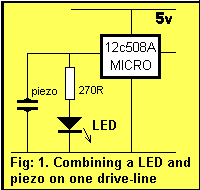
If the mark-space ratio of this waveform is kept short as shown in fig: 2,
the LED will only illuminate very dimly. A short mark-space ratio means the
"mark" is very small compared to the "space". A
very short on-time (mark) and a long off-time (space) will not affect the
tone from the piezo but will deliver very little energy to the LED and this is
exactly what we want.
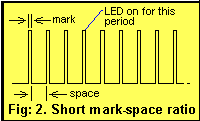
On the other hand, each time the LED is activated, only a very small click
will be heard, and this will hardly be noticeable. In this way the two devices
can be combined on the same line.
2. LED AND PUSH BUTTON
ON ONE LINE
In the Library of Terms and Routines we show how to connect two and up to
five or more push buttons on a single input line and generally you will not
have any problems adding buttons to a project. But if you want to add a secret
reset button (or a "cheat" button, for example), it can be added
across an existing LED as shown in fig: 3.
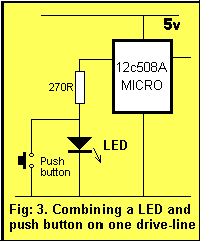
The resistor between the switch and micro acts as a safety resistor to
prevent the output of the chip being damaged if the switch is pressed when the
LED is activated, and it also acts as a dropper resistor for the LED.
These two items will work in combination because the impedance of the LED is
very high when no voltage is across it and when the micro turns the line into
an input line, it sees the LED as a high impedance. In other words it is not
detected so that when the switch is pressed the micro only sees the switch as a
LOW.
3. DIFFERENT PROGRAMS IN THE CHIP
Up to 5 different programs can be burnt into a single '508A and the required
program can be accessed by soldering a resistor between one of the outputs and
the "input-only" line - GP3, as shown in fig: 4.
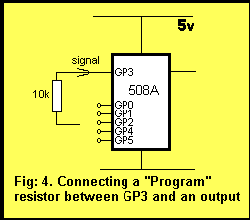
During turn-on, a special program will put a HIGH on each output in turn and
the output containing the resistor will determine the program. Combining 5
programs in one chip will reduce inventory costs as the required program can be
selected by fitting the resistor to the appropriate place on the board.
4. LINE REVERSAL
If a device is connected between two output lines as shown in fig: 5, a
program can be written so that the device sees a voltage reversal. When one
output is HIGH the other is LOW and this is then reversed.
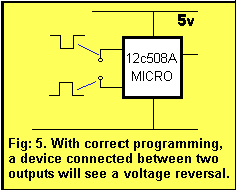
The drive lines have a maximum output current of 25mA and this is enough to
drive a number of different devices. If a red LED is connected in one direction
and a green LED in the opposite direction, they can be turned on and off
individually, as shown in fig: 6.
If the two LEDs are placed near each other or combined in the one LED
(called a tri-coloured LED), they will produce a number of colours including
orange, depending on the mark-space waveform delivered to each LED.
A single LED containing red and green chips is available in 2 or 3 lead
versions. The wiring for a 3-leaded tri-colour LED is shown in fig: 7. The
tri-leaded version is shown in fig: 6.
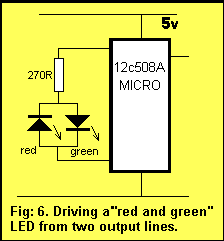
Tri-coloured LEDs are fairly expensive but if the project can cover the
expense, they can be the basis of "running message" displays and
simple TV screens.
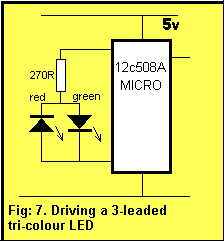
If you connect a piezo to two out-of-phase lines as shown in fig: 8b, the
sound produced will be slightly louder than the arrangement in fig: 8a.
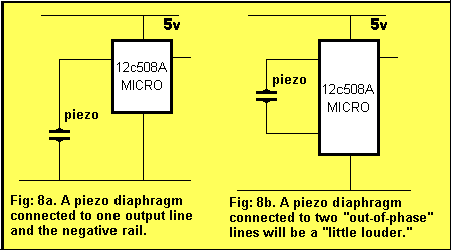
When we talk about a piezo we really mean a PIEZO DIAPHRAGM. A piezo
diaphragm is a passive device and is very similar to a capacitor as far as the
circuit is concerned. Ceramic substrate on a metal diaphragm causes the metal
to "dish" and bend to produce a high pitched sound. The size of the
voltage (the amplitude) determines the intensity of the sound and the frequency
of the waveform determines the tone.
The voltage across the piezo from one drive line is about 5v whereas the
voltage seen by the piezo from two reversing lines is about 10v. Unfortunately
this doesn't produce twice the sound output but the sound is slightly
louder. If you want a louder output you should use a better-quality high-output
diaphragm (such as from a Christmas card).
The loudest output is from a piezo siren and this is an active device
containing a transistor oscillator and choke. These units operate from 5v to
15v and produce a very loud output while consuming only about 10mA to 15mA.
5. DRIVING LEDs
Each output line of a '508A can only deliver about 25mA. This current is
determined by the size of the transistor delivering the current. The transistor
inside the chip is only very tiny and if a higher current is drawn, it may be damaged.
When a resistance of 200 ohms is connected from output to ground, a current
of 25mA flows (when the output is HIGH). If the resistance is reduced, a higher
current flows. This means a resistance of 200 ohms or higher is required
to make sure the current flow is less than 25mA.
But if a LED is placed on the output, how is the resistance worked out?
A LED drops a voltage across it according to its colour. This is called the
CHARACTERISTIC voltage or the CHARACTERISTIC VOLTAGE DROP. This voltage is
constant, no matter how bright the LED is illuminated.
For a red LED the characteristic voltage is 1.7v.
For an orange LED the characteristic voltage is 1.9v.
For a green LED the characteristic voltage is 2.1v.
LEDs cannot be connected directly to the output of a drive-line without a
voltage-dropping resistor. The reason is very technical but basically a red LED
does not turn on AT ALL until exactly 1.7v is placed across it and if the
voltage tries to rise above 1.7v, the LED will glow brighter, allow a very high
current to flow and will be damaged.
The only way to prevent damaging the LED is to provide it with a very
accurate supply voltage or simply connect a resistor in series. If the value of
the resistance is worked out, an accurate current can be delivered to the
LED and everything will be ok. The LED will last 100 years!
Suppose you want to deliver 25mA to a LED.
If we take a red LED, the value of resistance can be worked out by Ohms law.
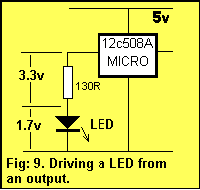
The voltage across the resistor is: 5v - 1.7v = 3.3v
I = V/R
0.025 = 3.3/R
R = 132 ohms Use 130R resistor.
6. DRIVING LEDs IN PARALLEL AND SERIES
If a number of LEDs are required to be driven from a single output, you will
need to connect them in parallel or series. There are limitations, however, as
you will see.
Firstly it is ok to connect two LEDs in series, provided you work out the
value of the dropper resistor.
If a single red LED is connected to an output and supplied with 25mA via a
130 ohm resistor, when two LEDs are connected in series, the second LED will
drop 1.7v and the supply voltage will
be 5v - 3.4v = 1.6v.
In this case the two LEDs will receive a current of 12mA from the 130 ohm
resistor and they may be a lot duller than expected.
To supply them with 25mA, the dropper resistor must be:
R = V/I
= 1.6/0.025
= 64 ohms
Use 68R resistor as shown in fig: 10.
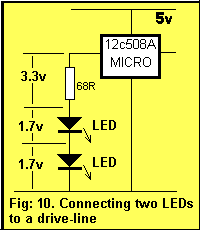
If three LEDs are connected in series, the total characteristic voltage drop
will be 1.7v + 1.7v + 1.7v = 5.1v This is higher than the maximum voltage on
the output line and in theory, the LEDs will not illuminate AT ALL, no matter
what dropper resistor is used!
This means only two LEDs can be connected in series to an output line.
LEDs can be connected in parallel AND series as shown in fig: 11. Four LEDs
is the maximum that can be driven from a single output line and this will
deliver about 12mA to each LED.

You will notice a separate dropper resistor is required for each column of
LEDs because LEDs cannot be operated in parallel due to the 1.7v characteristic
voltage required across each for perfect operation.
For example: one LED may have a characteristic of 1.75v and another may have
1.65v characteristic. The 1.65v LED will rob the other of voltage and prevent
it operating.
7. DRIVING MORE THAN 4 LEDs
If more than 4 LEDs are required to be driven, a buffer transistor will be
required as shown in fig: 12. This transistor will allow the LEDs to be driven
from a 12v supply (or higher) and the number of LEDs can be increased to
6 per column for 12v.
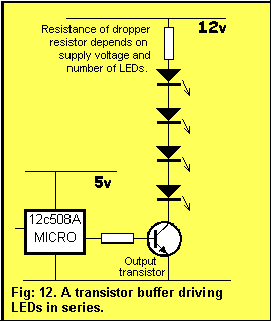
If the transistor can handle 100mA, four columns can be made, allowing 24
LEDs to be illuminated.
In this way segments of a large pattern can be illuminated.
Very large displays are simply a repetition of patterns. One of the oldest
displays I saw in operation was a set of thousands of globes outside a theater.
All the globes were illuminated and one band of globes was switched off in turn
to give a “running hole” effect. The mechanism to produce this effect was a
geared motor with an output lever moving past 4 micro-switches, turning off one
band of globes at a time. A very impressive result from a very simple circuit.
8. CONNECTING A GLOBE
A globe is a device that requires a very high start-up current. The start-up
or warm-up current for a globe is about 6 times its operating current and
although this current is drawn for only a very short period of time, it is
one of the reasons why a globe does not work in some circuits. The high
start-up current prevented one of our flip-flop circuits working. The
resistance of the leads from the project to the battery was sufficient to
prevent the circuit starting-up. To drive a globe from an output of the
microcontroller, a buffer transistor is needed.
Any type of transistor will be suitable providing its current handling
ability is about 600mA for each 100mA of operating current for the globe. A
suitable drive circuit is shown in fig: 13.
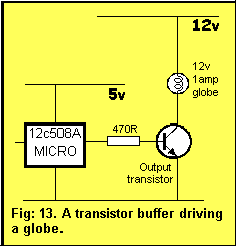
The globe can be dimmed by delivering a variable mark-space waveform. Fig:2
shows the type of waveform with the on-time represented by the "mark"
portion of the waveform.
9. CONNECTING A RELAY
Most relays require more than 25mA for operation and need a 12v
supply.
For this a buffer transistor is required. Fig: 14 shows how a relay is
connected to an output of the '508A. The diode across the relay prevents
voltage from the relay getting into any of the supply lines and affecting the
operation of the microprocessor.
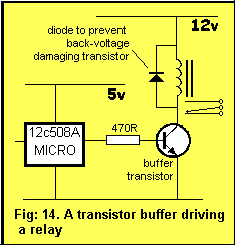
When the relay is turned off (de-energised) the collapsing magnetic field of
the coil generates a very high voltage and this can be passed to the supply
rail if it is not "snubbed." The diode absorbs (snubs) this
voltage.
10. CREATING SECURITY WIRING FOR AN ALARM
When designing an alarm project, the wiring between the sensors and the
control panel must not be able to be cut otherwise the alarm system is useless!
Making the wiring FULLY SECURE is very complex but a simple way to prevent
the wires being cut or joined together (without detection) involves a
line-sensing feature called LINE REVERSAL.
Most alarms consist of pin switches or reed switches with the windows and
doors physically keeping the switch closed or having a magnet to keep the
contacts of a reed-switch closed. If the door or window is opened, the circuit
becomes open and the alarm is activated.
This is called a CLOSED LOOP detection circuit.
It's very easy to see that if the two wires going to the alarm panel are
joined together near the alarm panel, the alarm will not activate when a window
or door is opened.
To overcome this problem a diode is placed in the line near one of the
sensors as shown in fig: 15.
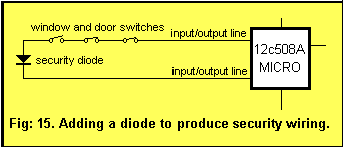
The alarm is required to send out a HIGH on one line and detect the high on
the other line. The alarm then sends out a HIGH on the other line and since the
diode is reverse biased for this condition, the alarm must sense a low on the
first line.
This "line testing" is done many times per second and if the line
is shorted, the program will detect the interference. The only limitation
to this system is the micro will not detect a diode fitted across the two lines
near the alarm panel. The thief has to know of this limitation and the
diode has to be fitted around the correct way to defeat the system.
How many thieves carry a diode with them and know how to fit it?
11. CONNECTING A MOTOR
In theory you can connect a motor with two drive-lines and get forward and
reverse operation. But unfortunately a motor requires a very high start-up
current and the drive lines of a '508A are not capable of delivering this
current. The solution is to use transistor buffers in the bridge
arrangement of fig: 16.
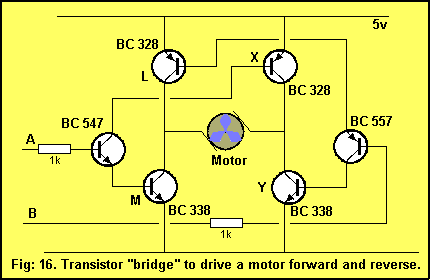
Lines A and B are two outputs from a '508A. There is an important point to
remember when programming the output lines to prevent a short-circuit occurring
with the bridge.
You will notice that if both A and B are HIGH at the same time, transistors
L, M and X, Y will be turned on at the same time and a short-circuit will occur
on the power rail.
To prevent this from happening lines A and B must be LOW at the beginning of
the program.
By taking line A HIGH, transistors M and X are turned on and this delivers
voltage to the motor to turn it in the clockwise direction.
To control the RPM of the motor, line A can be given a variable mark-space
ratio.
To reverse the motor, line A must be taken low and after a short delay, line
B can be taken HIGH. This will deliver voltage to the motor via transistors Y
and L and cause the motor to revolve in the opposite direction. Reverse
RPM can be adjusted with a variable mark-space pulse.
NEXT

| 















